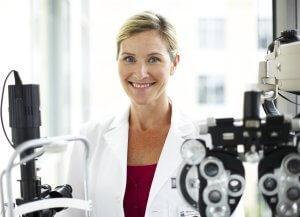Cataract Symptoms

Voted Best of Berks—
eight years in a row!
Most age-related cataracts start small, and you may not notice any changes in your vision right away. As the cataract grows larger, many people begin to notice blurry vision or other symptoms that may develop gradually over time.
The lens of the eye is located just behind the iris (the colored part of the eye) and the pupil. It is transparent so that light can pass through it easily. When working properly, light focuses on the back of the eye (the retina) to form clear, sharp images of what you see, and nerves transmit those images to the brain.
As we age, proteins in the lens start to break down and the lens gradually becomes cloudy. As a cataract develops, the lens delivers fuzzy images to the retina, causing blurred vision. There are three main types of cataracts – nuclear, cortical, and posterior subcapsular – and each type can affect your eyesight differently.
- Nuclear cataracts: These cataracts affect the center of the lens and are the most common age-related cataract. In the early stages, a nuclear cataract can increase nearsightedness. As it progresses, the lens gradually yellows and begins to cloud your vision. Many people find that colors become less vivid, and night driving can be particularly difficult.
- Cortical cataracts: A cortical cataract clouds the edges of the lens, called the cortex. These cataracts look somewhat like wheel spokes that point inward toward the center of the lens, causing light to scatter. Many people with this type of cataract experience problems with glare.
- Subcapsular cataracts: You may notice his type of cataract sooner because it develops at the back of the lens, directly in the path of light that is passing through on its way to the retina. It is most common in people who have had prolonged steroid use or suffer from diabetes. Common symptoms include blurry reading vision, halos and glares at night, and sensitivity to light.
Watch for These Signs
Cataracts are most often associated with the aging process, but can also affect younger people. Eye injuries, certain medications, and genetic conditions can cause cataracts, even in babies. These cataract symptoms and vision changes could also be signs of a different eye condition:
- Cloudy, blurry or distorted vision
- Light sensitivity
- Glare and halos around bright lights
- Increasingly poor night vision
- Frequent changes in eyeglass or contact lens prescription
- Fading or yellowing of colors that were once vivid
- Double vision in one eye
You may also notice that you blink more than usual to try to clear your blurry vision, or that you need more light to complete tasks that you were once able to do with normal light levels.
If you suspect you may have cataracts, be very careful at night and don’t drive when your vision is compromised.
See Your Doctor
The only way to know for certain if you have cataracts is to have your eyes examined by one of the cataract specialists at Eye Consultants of Pennsylvania. Our experienced doctors use specialized equipment to examine your eye’s lens and check for the presence of cataracts and other eye problems.
A careful exam is the first step to discovering cataracts or ruling out any other condition that may be causing your eye problems. Your doctor will explain possible treatment options, such as cataract surgery, and help you make the best decision so that you can see the world clearly again.
Our highly skilled cataract surgeons include:
Adam Altman, MD, who received his medical degree from the University of Massachusetts Medical School and was fellowship-trained at the prestigious Wills Eye Hospital.
Katherine Hu, MD, who graduated from the University of Virginia School of Medicine and performed her ophthalmology residency at the prestigious Wilmer Eye Institute at Johns Hopkins.
Lawrence E. Kenney, MD, who attended Temple University School of Medicine and completed his ophthalmology residency at Greater Baltimore Medical Center.
Christina Lippe, MD, who received her medical degree from the Pennsylvania State University College of Medicine and performed her ophthalmology residency at the University of Oklahoma.
Michael A. Malstrom, MD, who attended Temple University School of Medicine and completed his residency at Wills Eye Hospital.
Mehul H. Nagarsheth, MD, who received his medical degree from Drexel University College of Medicine and completed his glaucoma fellowship at Tufts New England Eye Center and Ophthalmic Consultants of Boston.
Abhishek Nemani, MD, who received his medical degree from the State University of New York Upstate Medical University in Syracuse and was fellowship-trained in at the prestigious Scheie Eye Institute at the University of Pennsylvania.
Jonathan Primack, MD, who received his medical degree from Washington University School of Medicine and completed a Cornea, External Disease, and Refractive Surgery Fellowship at the Massachusetts Eye & Ear Infirmary at Harvard Medical School.
Kevin J. Shah, MD, who received his medical degree from SUNY Upstate Medical University and received his fellowship training at the Cincinnati Eye Institute at the University of Cincinnati.
If you think you may be experiencing the symptoms of a cataract, get in touch with Eye Consultants of Pennsylvania to schedule an evaluation. We serve patients throughout Berks County, Schuylkill County and the areas surrounding Reading, Pottsville, Pottstown and Wyomissing, PA.
For an appointment, call toll-free 1-800-762-7132.
Find a Doctor
Physician information including education, training, practice location and more.
Schedule an Appointment
Call 800-762-7132 or make an appointment online.





